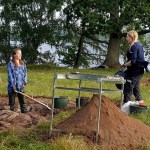Mesolithic
Ulvåsa in Ekebyborna is a manor near Motala with two known major Medieval elite settlement sites. Excavations in 2002 proved that the unfortified Gamlegården site was established before AD 1100. The fortified Birgittas udde site has seen no archaeological fieldwork since 1924, when the main building's cellar was emptied and restored. Its date is only known to the extent that almost all moated sites of this kind in Sweden belong to the period 1250-1500. My current book project deals with Östergötland province's fortified sites of the High/Late Middle Ages, and so I decided to spend two weeks…
Fornvännen 2013:2, last summer's issue, is now on-line in its entirety on Open Access.
My friends Mattias Pettersson and Roger Wikell on the Stockholm area's earliest post-glacial settlement site, covered here on Aard during fieldwork in 2010.
Tony Björk and Ylva Wickberg on an early-1st millennium linear monument related to a cemetery and a river ford in Scania.
Svante Fischer et al. on how mid-1st millennium sword fittings were re-used and deposited.
Magnus Green on a 17th century angel on the run from its job as embellishment on a nobleman's sarcophagus.
Olov Gibson on the unresolved…
The Mesolithic is the period between deglaciation and the introduction of agriculture in Europe (up to about 4000 cal BC in my parts). Within Swedish research into this period in recent years, no single site has been able to compete with the small town of Motala in Ãstergötland county. Located at a series of rapids on the main waterway from Lake Vättern to the Baltic, the spot has always been important for fishers and travellers. Its Mesolithic record has gained the limelight thanks to major railroad construction in an area with waterlogged sediment that preserves organics. Thus any number…
Current Archaeology #254 (May) has a pretty funny 6-page feature by Spencer Smith of the Royal Commission on the Ancient and Historical Monuments of Wales. He claims to have found the site of a Surrey manor house that saw the birth of the last Prince of Wales who was actually an independent Welsh prince: Owain Lawgoch, Owain of the Red Hand (b. c. 1330, d. 1378). But reading the article, I found that it is actually a long piece of special pleading to explain why Smith did not find the desired remains on site! The whole thing was prompted by a TV documentary, where of course you have to put a…
Dear Reader, do you come across a lot of ancient blubber concrete in the course of a normal day? I got some exciting news from Mattias Pettersson Tuesday morning regarding his and Roger Wikell's Mesolithic sites in the Tyresta nature reserve. As Aard's regulars know, Tyresta is a former archipelago that is now wooded highlands due to isostatic land uplift, all full of early post-glacial seal-hunting camps. It's easy to share Mattias's enthusiasm (and I translate):Does anyone remember the burnt bubbly lumps we found under the hut floor at the 85 m a.s.l. site in Tyresta? Now Sven Isaksson of…
Motala in Ãstergötland has been recognised in recent years as one of the richest Mesolithic sites in Scandinavia north of the current and former Danish provinces. Excavations in waterlogged sediment along River Motala ström have produced great numbers of bone and wood objects that have rarely been preserved elsewhere. Most are harpoon and leister points, but now a bone dildo (a boner?) has joined the growing collection. Measuring twelve by two centimetres, its size is perhaps not very impressive, and there are many non-dildoish uses for which it may have been intended. But without doubt…
Wednesday was another day guest-digging at one of Mattias Pettersson & Roger Wikell's sites in the Tyresta woods, this one in the huge denuded area of the great forest fire. Otherworldly scenery! It's the unusually high site discussed here three years ago by Mattias. And since we're dealing with seal hunters in an area with swift shoreline displacement, it's in all likelihood the oldest of the lot: 10 000 years, give or take half a millennium. It's so old that it's pre-stone-axe. The characteristic greenstone flakes left over from the making of Mesolithic axes don't go as high as this.…
Three cool pieces of science have been retrieved from the depths.
In the L'Atalante basin, one of the Mediterranean sea's deep hypersaline anoxic basins, anoxic metazoans have been discovered. That means multicellular beings like you, Dear Reader, who live without oxygen. They're loriciferans, Sw. korsettdjur, each less than a millimetre long. Instead of breathing like you, aided by endosymbiotic mitochondria, these beasties have another kind of power plant inside their cells similar to hydrogenosomes, that is, they're chemotrophic.
In a bog on the high wooded hills of temperate Hanveden…
I got a great letter from Reggae Roger Wikell, which I publish in translation with the permission of Roger and Mattias Pettersson with the awesome metal hair. For context, note that these two scholar friends of mine are the area's foremost authorities on Mesolithic sites that have ended up on mountaintops due to post-glacial shoreline displacement. The lithics there are mainly quartz.Not all that glitters is quartz.
Yesterday we had a planning meeting with Dr. Risberg [quaternary geologist and the Stockholm area's main shoreline displacement guy]. We're going to core bogs at high elevations…
I've filed the Sättuna excavation report with the State Board of National Antiquities, the County Archaeologist's office and the County Museum. And I've put it on-line at archive.org. Check it out if you're into the Late Mesolithic! We didn't get much data on the 6th century elite settlement.
I'm almost done with the report from my excavations at Sättuna in Kaga last September. Here's an excerpt.
Finds and radiocarbon dates allow us to identify five phases on-site, two of them corresponding to the dates of the metal detector finds that occasioned the excavations.
Late Mesolithic: finds and features with one radiocarbon date.
Middle/Late Neolithic: one hearth with a radiocarbon date, no finds.
Mid-1st Millennium AD: a pit and a hearth with two radiocarbon dates, no finds.
Viking Period: one posthole with a radiocarbon date, no finds.
Modern rubbish pits.Late Mesolithic
This phase…
Today I joined my friends Mattias Pettersson and Roger Wikell for a day of digging on an Early Mesolithic seal hunting station in the landlocked former archipelago of Tyresta. The Urskogsstigen 4 site is currently on a wooded hilltop at about 77 meters above sea level, and thus likely to date from about 8000 cal BC, shortly after deglaciation. It's not in the area denuded by the 1999 forest fore. What's really striking about this particular site (Mattias & Roger have found hundreds) is that it's very early, it has enormous amounts of quartz débitage and it has a tent-sized cleared area…
[More blog entries about archaeology, Mesolithic, Sweden; arkeologi, mesolitikum, jägarstenåldern, Stockholm.]
My old buddy from undergrad days, hard-core Mesolithic scholar, painter and woodsman Mattias Pettersson, sent me a pair of wonderful breathless letters on 19 and 21 July about new high-end discoveries. This is all about ancient seal-hunting camps in an area with dramatic shore displacement, which is why Mattias is so happy to get high -- 75 meters above current sea level! High means early here, so early that the top sites are pushing the chronological limit set by the last Ice Age. (…
[More blog entries about archaeology, Sweden, Mesolithic, forestfire; arkeologi, mesolitikum, Tyresta, skogsbrand.]
Spent Friday working for my friends Mattias Pettersson and Roger Wikell, digging on one of their Mesolithic sites in the Tyresta nature reserve south of Stockholm. It's an incredible place. Imagine:
An archipelago with lots of little rocky islands, located far from the coast of the mainland and teeming with seals. Mesolithic people go there in kayaks to hunt at certain times of the year, bringing chunks of rock for toolmaking. At their camps, they knap it into arrowheads,…

